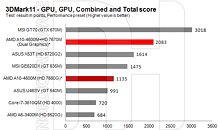Wednesday, April 25th 2012

AMD A10-4600M Performance Revealed in Infographic
AMD revealed performance numbers of its key product for mainstream notebooks, the A10-4600M, in an infographic for the Korean market. Besides detailing the part, it reveals some performance numbers. To begin with, A10-4600M is based on the 32 nm "Trinity" silicon with all its components enabled. It has four x86-64 cores spread across two "Piledriver" architecture modules, 4 MB of total cache (2x 2 MB), CPU clock speeds of 2.30 GHz (3.00 GHz TurboCore), and integrated Radeon HD 7660G graphics that has 384 VLIW4 stream processors, and GPU core speed of 685 MHz. The chip integrates a PCI-Express 2.0 root complex, and dual-channel DDR3-1600 MHz integrated memory controller.
Moving on to performance numbers, and as expected, the infographic doesn't touch comparative CPU performance with a barge-pole. Instead the focus is on graphics performance, with an emphasis on Dual GPU feature, where the integrated graphics can work in tandem with a discrete GPU of the same class, resulting in up to 75% performance increase. Based on data from this infographic, and its own testing data of other notebooks, NordicHardware compiled relative performance of the IGP and Dual Graphics setup involving the A10-4600M and Radeon HD 7670M discrete GPU.
Source:
NordicHardware.se
Moving on to performance numbers, and as expected, the infographic doesn't touch comparative CPU performance with a barge-pole. Instead the focus is on graphics performance, with an emphasis on Dual GPU feature, where the integrated graphics can work in tandem with a discrete GPU of the same class, resulting in up to 75% performance increase. Based on data from this infographic, and its own testing data of other notebooks, NordicHardware compiled relative performance of the IGP and Dual Graphics setup involving the A10-4600M and Radeon HD 7670M discrete GPU.




31 Comments on AMD A10-4600M Performance Revealed in Infographic
Here
Its probably the only place in the AMD/INTEL market where AMD is doing a little better.
Looking good Trinity
That's the older and slower 6620G and a quick estimation (from looking at the benchmarks) says it's about %20ish percent faster than the HD3000. Soo.. Yeah. It's faster. The CPU is not that fast though.
Sandy Bridge 0 --> Ivy Bridge 600-700. Yes nice improvement over Sandy Bridge:D, but not even on Llano level:cool:.
Dual Graphics is also just a gimmick as long as AMD won't support it properly and fix the stutter issues. It's only good for 3DMark for now. I'd only consider adding the discrete gpu for 17" models. I suppose it has marketing value, but people just get disappointed when they actually try to make it work like it's supposed to.
It's unfathomable how AMD got to this state after Phenom. If only they had just ditched it in time and kept enhancing Phenom until they actually got something that worked. AMD likes to point out that they have a "forward thinking" architecture and in the future it will be better utilized. Perhaps they should've also left BD for future too, since nobody wants it today.
I see AMD having some ideas as to how to compete against Intel in the future, but I highly doubt they will be able to execute those plans. Stuff like heterogenous computing will require more resources for it to work than what AMD can pull off, and it'll end up like most AMD's innovations: Buggy and unsupported by developers.
I'll stand by my continual statement that the only BD chip worth buying is the FX-8120, because at the price point with even a modest OC it's a solid offering, but the rest of the BD line is pretty much garbage.
As for the actual topic at hand, I am interested in one of those "dual-GPU" Laptops, could make for a decent light gaming laptop on days I just want to sit on the couch or lay in bed. I'd like to see some real world performance numbers, I hate just 3DMark scores.
AMD, please improve your CPU in your APU, perhaps I shall consider getting one
Yours sincerely,
Potential Customer
They mentioning here really good battery times, like 3:20 hours 3DMark06, but probably this is just with 9cell battery and in the most optimal case.
I'm also really curios if GPU or CPU can be overclocked or no. Curios if FS1r2 compatible with FS1r1 or not?...
I'm sure AMD is not worried about you.
I would like to see official benchmarks, getting sick of these glossy marketing ones. When will TPU conduct their review?
But more CPU power would be nice, but on the whole I think these things are pretty well balanced for appropiate tasks. Like in HTPCs, desktops for avarage users etc.
-----------------
I found this interesting review / preview/ leak? of the new Trinity APU.
The Trinity 4 core APU (4.2GHZ) faster clock for clock against Bulldozer FX 8 core (4.2GHz), which is good for a low end APU.
www.overclock.net/t/1241387/tpu-amd-trinity-piledriver-integer-fp-performance-higher-than-bulldozer-clock-for-clock
post #5